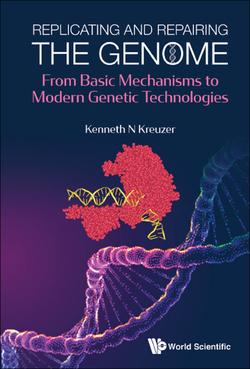Читать книгу Replicating And Repairing The Genome: From Basic Mechanisms To Modern Genetic Technologies - Kenneth N Kreuzer - Страница 13
На сайте Литреса книга снята с продажи.
1.4Repairing and tolerating damage to the DNA molecule
ОглавлениеIn spite of its central role in heredity, DNA is prone to diverse forms of damage. The most frequent form of damage involves loss of a purine or pyrimidine base, which occurs thousands of times a day in human cells. Bases are also altered within the DNA molecule into a different form, for example, the relatively frequent deamination of a cytosine residue into uracil. Numerous chemical and physical agents promote these and many other forms of damage to the DNA molecule. Interestingly, even the endogenous chemicals within a cell can damage DNA, for example, the essential cofactor S-adenosylmethionine can methylate adenine residues in DNA, and metabolic oxygen radicals cause various forms of oxidative DNA damage. The forms and causes of DNA damage will be elaborated in more detail in Chapter 8.
Conceptually, the simplest form of DNA repair involves chemical reversal of the damage to restore a completely intact DNA that is indistinguishable from the DNA prior to damage. This direct damage reversal pathway can occur with only a few specific forms of DNA damage and relies on special proteins that evolved specifically for the reversal reaction (see Chapter 9). For example, ultraviolet light (UV) leads to covalent linkages between two adjacent pyrimidines, and enzymes called “DNA photolyases” can reverse these linkages dependent on the adsorption of light. Another group of direct damage-reversal pathways acts on DNA bases that have been damaged by the addition of an alkyl group. A number of proteins can recognize specific forms of alkylated bases and directly reverse the alkylation, releasing the normal undamaged base as a product.
As mentioned above, the information redundancy on the two strands of the DNA duplex provides a fundamental opportunity to repair DNA damage without losing any genetic information. As long as the damage is on only one strand of a DNA duplex, the offending segment of DNA can be removed and replaced by a DNA polymerase reaction that uses the intact, undamaged opposite strand as a template. This forms the basis of several critical repair pathways, including base and nucleotide excision repair (Chapter 10) and mismatch repair (Chapter 6).
When the damage to the DNA molecule involves both strands, such as a double-strand break (DSB), the information redundancy in the two strands is irrelevant. Nonetheless, cells have evolved surprisingly robust pathways to repair DSBs and other forms of damage that impact both strands. As will be described in Chapter 11, one set of DSB repair pathways uses homologous DNA as a template to generate an error-free product. In diploid eukaryotic cells, for example, a break in the maternally derived chromosome can be repaired with the assistance of the paternally derived chromosome. Similarly, after the process of DNA replication, a break in one of the two duplex replication products (called sister chromosomes) can be repaired with the assistance of the other. A second set of DSB repair pathways, called nonhomologous end joining, simply reconnects two broken ends without using any template to try to ensure correct alignment. This pathway often involves the addition or removal of some bases from the DNA ends, leading to frequent mutations at the site of the break.
When considering the various forms of DNA damage, it is critical to distinguish between DNA damage and mutation. As we have seen above, DNA damage can often be reversed or repaired in such a way that the repaired DNA molecule is identical to the starting DNA, with no changes in the DNA sequence. On the other hand, a mutation in DNA is a heritable change in the DNA sequence. A particular form of DNA damage might, at some frequency, lead to a mutation at the site of damage, but the damage itself is not a mutation. It is also important to note that the accumulation of a certain amount of DNA damage might lead directly to cell death, for example, because the cell can no longer replicate its DNA successfully. On the other hand, a small subset of mutations might also cause cell death or other untoward effects by a completely different mechanism, for example, by changing or destroying the activity of an important cellular enzyme. While detailed mechanisms of mutagenesis (creation of mutations) are beyond the scope of this book, we discuss in later chapters certain mutation pathways in the context of DNA replication errors and specific DNA repair pathways.
The distinction between damage and mutation is particularly striking and relevant when discussing the special class of translesion DNA polymerases. These polymerases have the surprising ability to synthesize opposite a damaged base without using that base as a template. Obviously, this can lead to a mutation, and indeed these DNA polymerases were discovered as causing a subset of mutations in cells. Nonetheless, translesion polymerases assist the cell in surviving DNA damage, as will be discussed in Chapter 12.
In the closing two chapters of this book, the basic knowledge about replication and repair pathways/proteins will be used to appreciate certain human disease states and also the burgeoning field of biotechnology. Numerous human diseases, particularly cancer, involve heritable (germ line) or newly formed (somatic) mutations in the genes that encode proteins involved in DNA replication and repair (Chapter 14). Also, many of the tools used in modern genetic technologies are completely dependent on proteins involved in replication and repair, often derived from simple bacterial systems (Chapter 15).
